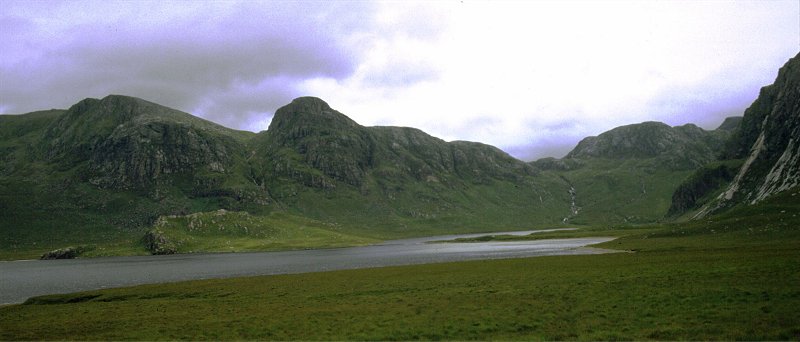

Between Loch Maree and Little Loch Broom is a large tract of mountainous and remote ground that has long attracted a more intimate exploration. In 1999 we had met a couple of walkers in the Dundonnel Hotel who had traversed the region from Poolewe, taking in the remote Munro top of A' Mhaighdean on the way. They recommended the walk and it was on our list for the next annual trip to Scotland.
One of the main problems in walking across the region is to find the means of returning to your starting point. We enquired at the Tourist Office in Ullapool but failed to ask the right question - no mention of busses running along the Ullapool to Gairloch route expect on one day per week - essentially linking the communities for a weekly shopping trip. We later found out that there IS a daily service running around the region - from Inverness it runs to Laide on the coast (doesn't take in Ullapool you see). Three times in the week it runs along the northern side via Dundonnell to Gairloch, on the other days it runs along the southern side via Kinlochewe to Laide. Excellant.
So we had the means to close the loop, now to organise the route and timing. In crossing the Fisherfield region the only major question is on the large river crossings that are found at the entrance to Loch na Sealga under the southern slopes of An Teallach. In spate these are impassable, but in summer they are usually fordable - albeit that you do get wet feet. The transport also determines the approach - to leave the car at Corrie Hallie in the north forces you to catch the early morning bus back to the car as it sets off to Inverness. Whilst the option of starting at Poolewe gives the more logical conclusion of catching an evening bus back to the starting point. The only catch is that you have to decide your exit point to coincide with the day on which the bus runs along that particular road. In settled weather conditions this is unlikely to be an issue but in poor weather a decision has to be made on getting to Kinlochewe or Corrie Hollie. We knew from the guide books that shelter could be found at Carnmore - at the head of Fionn Loch - and Shenavall - a busy Bothy under the southern slopes of An Teallach.
We decided to leave the car at Poolewe, walk in to Carnmore with the aim of climbing A'Mhaighdean (The Maiden) the following day, then take a leisurely day and half to walk out to the north via Shenavall. It was August 2000 and if successful we would have climbed two of the most remote Munros within a week - having tackled Seanna Bhraigh a few days before. It was not to be.
One False Start
Day One - Poolewe to Carnmore
Day Two - Carnmore to
Kinlochewe
The
Aftermath
The plan had been to start walking on the Monday but the weather was wet at Achnahaird. We still got up and packed but with little urgency. We stopped in Ullapool for a cooked breakfast at Mountain Man cafe - £4.25 per head for the full thing including coffee. We got served before the influx of travellers from the Stornoway ferry. It was still raining.
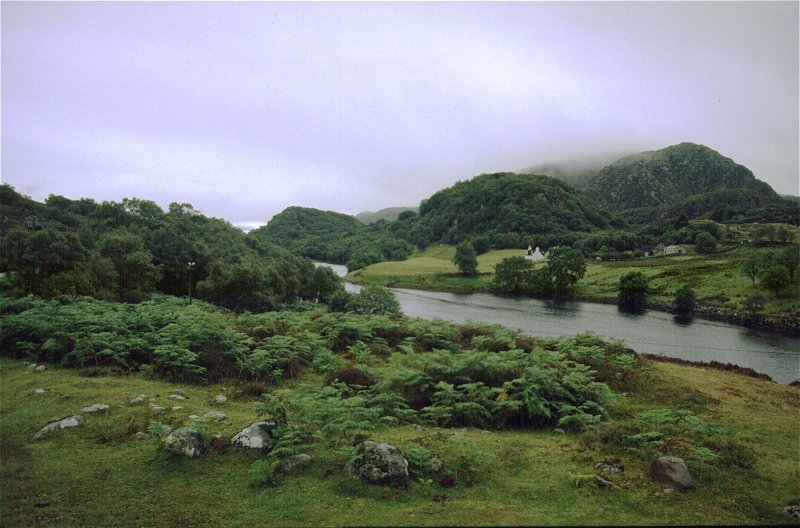
It is nearly 60 miles by road from Ullapool to Poolewe and by now we were amid the ambling holiday traffic. It did not stop raining and every time the road left the coastal fringe we found ourselves in mist. At Poolewe we had a quick look round, deciding that the car could be left in the parking bay by the river just in front of the school. We had set 2:00pm as the latest departure time (12 miles to Carnmore - 5 hrs) but we were drinking beer at The Old Inn in Gairloch well before that. The walk was posponed 24 hrs and we pitched the tents at Big Sands.
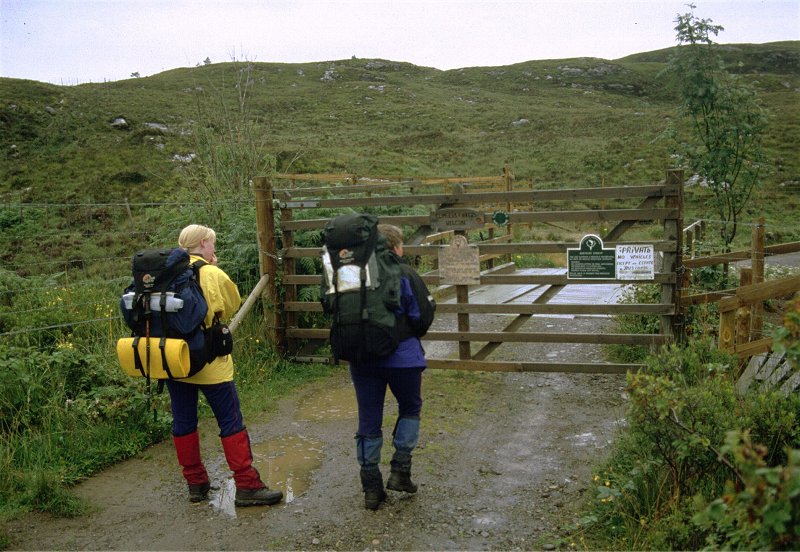
Tuesday 8th August, 2000
The next morning was heavily overcast but it had stopped raining. The mist hanging on the hills could/should lift. We decided to make a go of it. We changed the 'Monday' to 'Tuesday' on our note and dropped it through the police station door in Gairloch. We phoned also but got put through to Dingwall so we left a message to be passed on.
At Poolewe the weather was in balance - we bought some bread rolls and other bakery items for the day from the Post Office before setting off along the neatly tarmacadamed drive towards Kernsary.
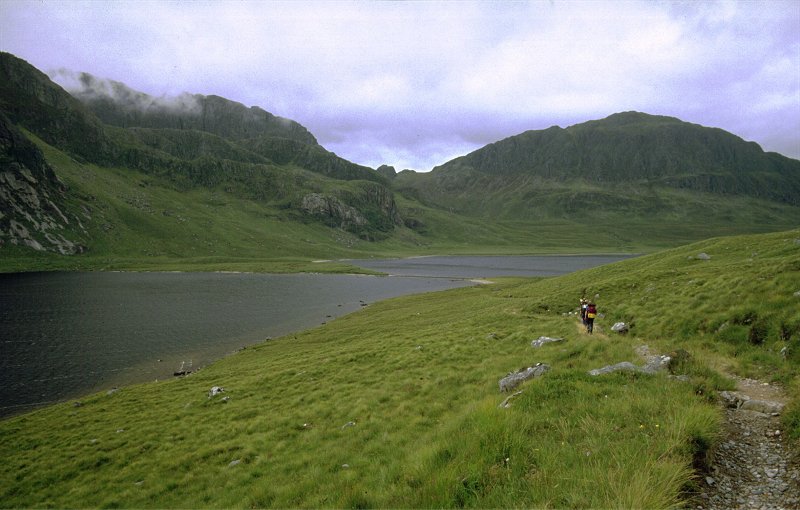
The drive passes through a gate in the woods on the first easy going stretch - the low crags above the river were still covered in mist but still no rain. The tramac surface ends at the turn to Inveran and the track continues a more undulating route through the craggy scenery. A second gate at the bridged crossing below Loch Kernsary is festoned with messages of 'Welcome to Walkers and Climbers' from the Estate, and 'Protect this most valuable wilderness (no camping, no fires, take litter home, keep to paths, etc.)' from an unknown body.
Kernsary itself is a relatively small cottage and a focus for all routes into 'The Wilderness' and back to Poolewe. The first track heads over the shoulder to the shoreline on Loch Maree at Ardlair. We took the next eastbound path turning off into the woods just behind the cottage - a hand written note in biro on the deer gate pointed 'Path to Carnmore through forest'.
The original path east has been replaced by a new construction slightly to the north. A notice respectfully requests that the new route is followed - continue along the forest track NE to the end, then turn SE through a wide break in the trees to a stile onto the open hillside under Torr nan Gabhar. The extra height gained in the forest is maintained as the path strikes east across the hillside - the orginal route is picked up some 2km further on near the junction at grid ref 927775.
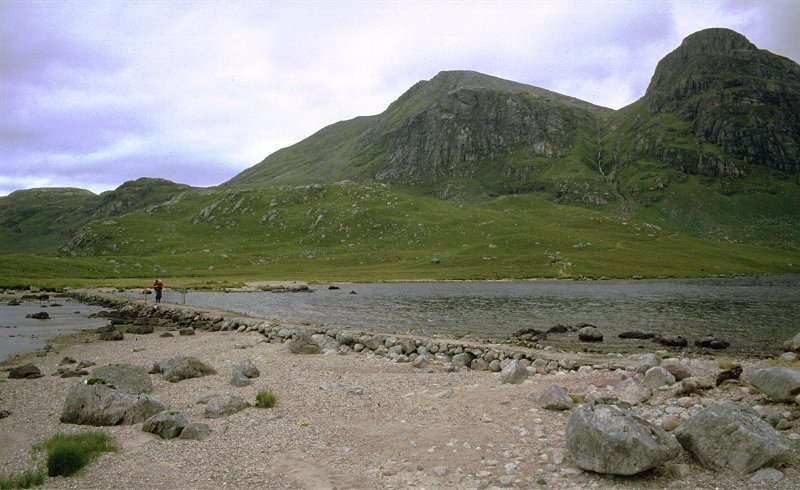
With the cross streams protected by key stones, a protective drainage ditch on the uphill side and a prepared surface (no cobbles!) this makes for an easy passage. Certainly easier than the very muddy stream-side route of the original path.
The rain now caught up with us and full waterproofs were donned. The cliffs to the south (our right) were hidden in cloud - Fionn Loch to the north could not be seen. There was nothing for it but to push on steadily, past numerous lochans, towards our goal and hope the 'shower' would pass over. A large break in the mountain ridge gives an easy route through to Letterewe on the shores of Loch Maree, the Strathan Buidhe. Here we dropped down to an old sheep fold for a rest. In the still, damp air the midges were out in force and it was only a quick bite of biscuits - no-one fancied the effort of making a cup of soup. We sat on the stream bank in full waterproofs and midge hats.
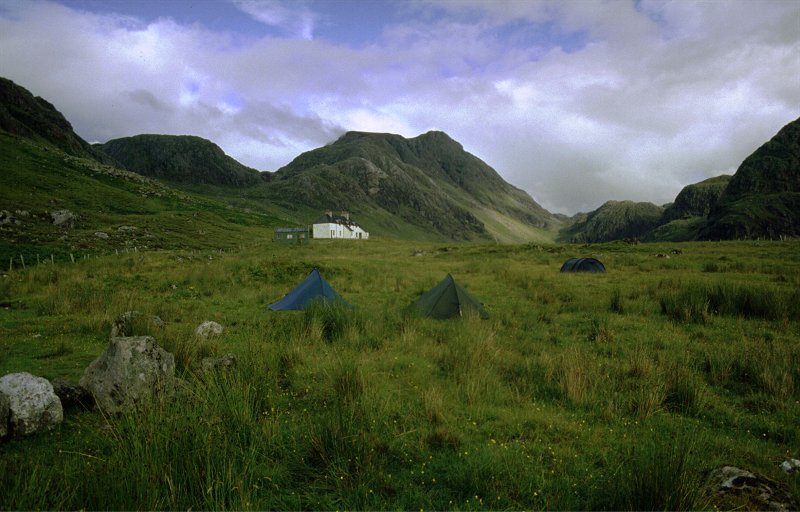
A clear path crosses the stream in the valley - avoiding the detour shown on the map. It is only about an hours walk to Carnmore from here. A lone walker passed us - he was clearly intent on travelling further than we were and he was last seen climbing the path to Shenaval above Dubh Loch. On the next stretch three overseas visitors passed us heading for Poolewe - they were not well kitted out and were wet through. Carnmore bothy was, they said, 'basic' but had a good roof. Somewhere dry at least.
We were now approaching the foot of the high cliffs that enclose the head of Fionn Loch and practically encircle Dubh Loch - a most impressive amphitheatre. As we dropped towards the lochside and the causeway between Fionn Loch and Dubh Loch the mist started to lift a bit to reveal the high cliffs that suround this enclave in the hills.
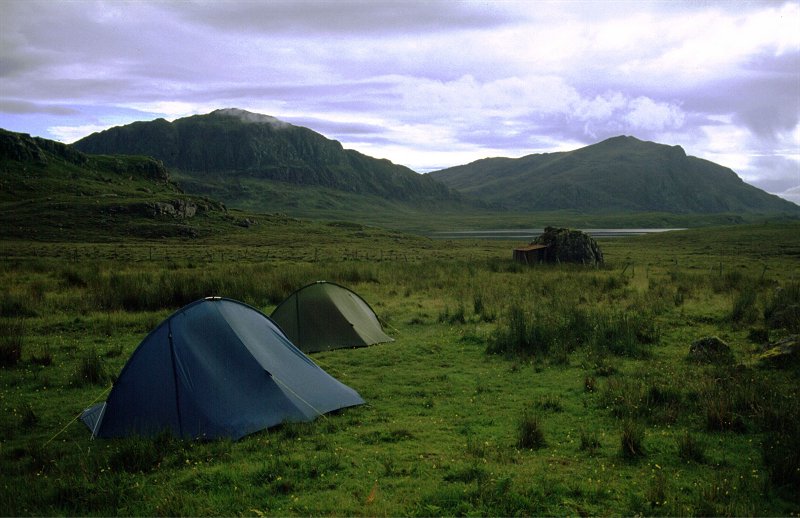
The causeway has a concrete surface and separates the two lochs - although the difference in water level is only a few inches. Two wooden gate posts had been placed half-way across - some fierce metal spikes lay in the water. Beyond Carnmore lodge is a well maintained white painted residence and was occupied at the time of our visit. A notice offers use of the nearby 'barn' to walkers and climbers. This structure does indeed have a good (metal) roof - but no floor. An accumulation of old bivy bags covered the dirt and boulders. The walls are not plastered and the wind could whistle through - some of the larger gaps had been stuffed in an attempt to cut out the worst of the draughts. A dustbin was provided for rubbish.
Not finding the accommodation ideal we had a word with the occupants of the house and arranged to pitch our two small tents on an adjacent piece of flat ground. The midges were out in force and we lit two coils in the shed to clear them out whilst we had a brew. We were joined by two Germans who had similarly departed Poolewe that morning - they also pitched a tent.
A lone walker arrived later having taken in all the Munros this side of Shenaval. Most of these had been done in mist although it had cleared at around 6:00pm as he reached the final peak of the day - A'Mhaighdean.
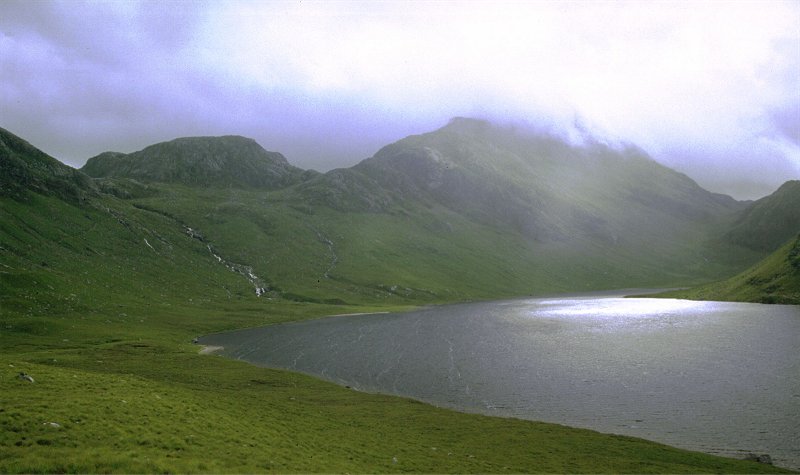
The tops indeed cleared and an evening breeze arrived to clear away the midges. We took a few photos in the evening light and wandered back to the causeway. Here we found an estate worker fitting a gate and latch to the two posts - this (and the spikes) were to keep the estate ponies from slipping across the loch and back home when they were needed on the high hill pastures to help with the stalking.
We bedded down in the hope that the weather would stay clear and that we would be able to take in A'Mhaighdean and the red summit of Ruadh Stac Mor, the second top that could be seen over the back. We were told the path to the col and these two summits was clearly defined and easy to follow. Would the next day dawn clear?
One False Start
Day One - Poolewe to Carnmore
Day Two - Carnmore to
Kinlochewe
The
Aftermath